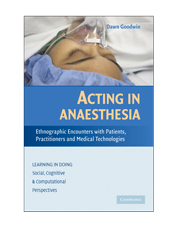Book contents
- Frontmatter
- Contents
- Series Foreword
- Acknowledgements
- Acting in Anaesthesia: Ethnographic Encounters with Patients, Practitioners and Medical Technologies
- 1 Understanding Anaesthesia: Theory and Practice
- 2 Refashioning Bodies, Reshaping Agency
- 3 Accounting for Incoherent Bodies
- 4 Teamwork, Participation and Boundaries
- 5 Embodied Knowledge: Coordinating Spaces, Bodies and Tools
- 6 Recognising Agency, Legitimating Participation and Acting Accountably in Anaesthesia
- References
- Index
- Titles in the series
4 - Teamwork, Participation and Boundaries
Published online by Cambridge University Press: 20 August 2009
- Frontmatter
- Contents
- Series Foreword
- Acknowledgements
- Acting in Anaesthesia: Ethnographic Encounters with Patients, Practitioners and Medical Technologies
- 1 Understanding Anaesthesia: Theory and Practice
- 2 Refashioning Bodies, Reshaping Agency
- 3 Accounting for Incoherent Bodies
- 4 Teamwork, Participation and Boundaries
- 5 Embodied Knowledge: Coordinating Spaces, Bodies and Tools
- 6 Recognising Agency, Legitimating Participation and Acting Accountably in Anaesthesia
- References
- Index
- Titles in the series
Summary
Anaesthesia is, of course, not accomplished by the anaesthetist alone. The patient, even when unconscious, can be seen to play an active role, and in terms of understanding these rather ambiguous expressions and rendering accountable ensuing actions and interventions, the activities of nurses and ODPs are deeply implicated. In the previous chapter, however, the participation of nurses and ODPs passed largely without discussion. In this chapter, I address this issue directly, focussing closely on the participation of nurses and ODPs and the scope these practitioners have to inform and shape anaesthetic care. I am interested to elucidate how anaesthetic practice is partitioned across different workers and how different agencies, knowledges and practices are imbricated and interwoven in the organisation and delivery of health care. I am also interested in the limits to the participation and practice of nurses and ODPs, how these limits are enacted, supported and transgressed, and the consequences or effects of doing so.
Knowledge, Work and Multidisciplinary Teams in Health Care
The term ‘multidisciplinary teamwork’ does not do justice to the complexities and intricacies of the processes it purports to describe. DiPalma (2004) points out that the common-sense notion of ‘teamwork’ is too simplistic, conveying an overly orderly and predictable process. And as I indicated in the first chapter, neither is there anything straightforward about the composition of ‘multidisciplinary’ teams; on the contrary, the members of the team will vary considerably and whilst each participant will have a given role, there also will be overlaps between the skills and knowledges of the practitioners, enabling them to flexibly cover certain tasks as needs and circumstances dictate.
- Type
- Chapter
- Information
- Acting in AnaesthesiaEthnographic Encounters with Patients, Practitioners and Medical Technologies, pp. 105 - 138Publisher: Cambridge University PressPrint publication year: 2009



